- Author tells you about the various Fine Arts that were discussed, explained and showcased at the Khajoraho Utsaav 2021.
The 'Khajoraho Utsaav' this year indeed appeared as a celebration of all finer things in life and not just merely a dance festival. One could witness a display of the Folk culture, traditions and creations showcasing terracotta, ceramics, handlooms in the 'Art Conclave' and Paintings and Sculptures in the 'Art Mart'. There was a showcase of Films & Documentaries as part of 'Chal Chitra' on one hand while Art talks and discussion forums brought expert insights in 'Kalavarta'.
The festival even gave tourists an option to quench their desire to have local Bundelkandi delicacies at 'Swad' and opportunities to display traditional Indigenous Fete in 'Hunar,' all planned well under one roof but in distinct segments. This fete of Fine Arts was indeed designed with a vision to make Khajuraho an Art destination.
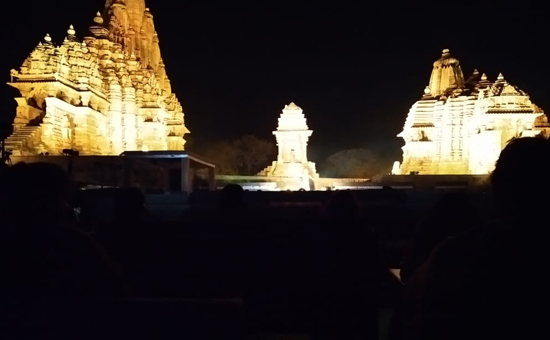 Dance Festival inside temple complex after 47 years.
Dance Festival inside temple complex after 47 years. For years
Festival Director Rahul Rastogi always wondered why the Khajuraho Dance
Festival took place outside the temple complex! Although it must be said that
ambience outside was so well created with Chitragupta Mandir as a backdrop that
the audience watching it on television could never think, it was not happening
inside the complex.
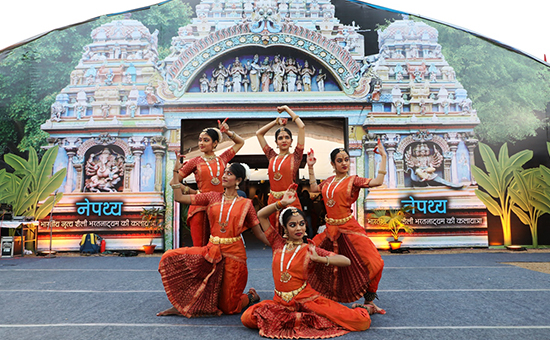
He says, "I never gave up on the idea of having the festival amid the temples, as it happened at the time of its inception but gradually stopped. This year with the grace of God the wish was granted with the help of the Archaeological Survey of India."
Elaborating on the concept of 'Khajoraho Utsaav' he says," The Utsaav is an overall representation of the interconnectedness of various fine arts (Lalit
kalayen) as mentioned in Bharat's Natyashastra, be it Dance, Drama, Music, Poetry, literature, sculpture, paintings or even food."
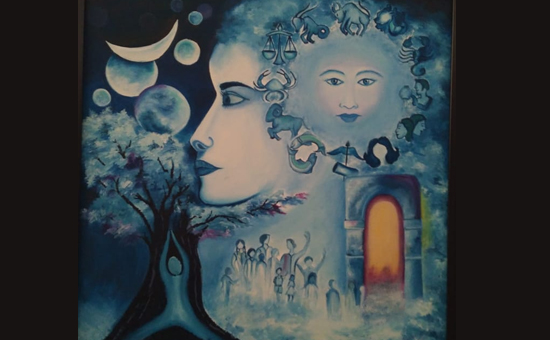 Painting on display
Painting on displayIn an endeavour to provide economic support to the artists and the artisans from the Khajuraho Dance Fiesta, an 'Art Mart' was designed to display artworks, wherein the creators were provided with an opportunity to both exhibit and have live interactions with the onlookers. This year the 'Art Mart' was themed ‘The City of Women’ dedicating it to the women artists. The Mart displayed 500 artworks created by 250 promising women artists coming from all over India including Madhya Pradesh.
The selection process included the creation of 25 groups of artists, wherein each group could represent a maximum of ten artists. Each artist submitted two artworks from each group. Two artists from each group were hosted by Kala Academy Madhya Pradesh to represent their group at the Festival Exhibition. The exhibition displayed artworks across genres from paintings, drawings, sculptures depicting various styles namely traditional art, graphic, abstract, semi-figurative art, along with folk and tribal art. Art Mart acted as an interactive platform for the students of art and amateurs to have a tete-e-tete with artists and artisans. The festival this year bestowed a distinct live energy to it as one could witness a plethora of exquisite art pieces being created there and then.
 Handwoven products on sale
Handwoven products on saleThe 'lokotsav' was indeed a celebration of the folk culture and traditions which brought in handloom weavers weaving the golden silk chanderies to potters creating clay pots and pottery sculptures.
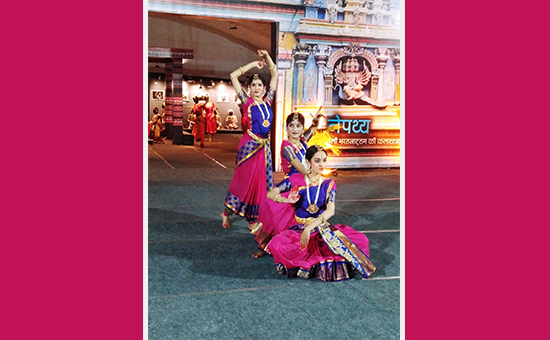 Dancers at nepathya.
Dancers at nepathya.'Nepathya' was a spectacle of the journey of Bharatnatyam, giving a glimpse into its rituals of Gurushishya Parampara, history of the form along with showcasing a range of costumes.
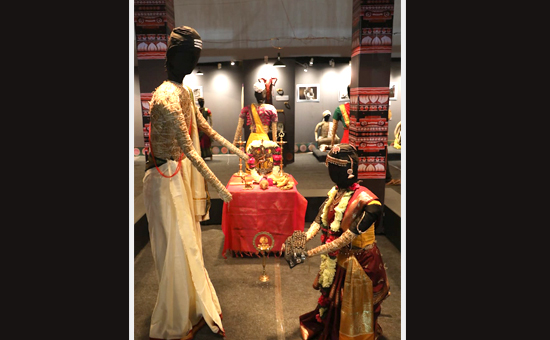 Guru shishya parampara pic Nepathya.
Guru shishya parampara pic Nepathya.'Kalavarta' - A Dialogue on Arts brought together eminent performers, historians, visual creators, presenters, art critics, connoisseurs and intellectuals to interact with the audience. Their ideas on the philosophy and relativity of Indian culture and art forms were shared, how they could move ahead creating value in society.
With
their legacy or the art form theses experts tried combining their intellectual
flavour with a philosophical approach to enlighten the art connoisseurs and
students at the same time.
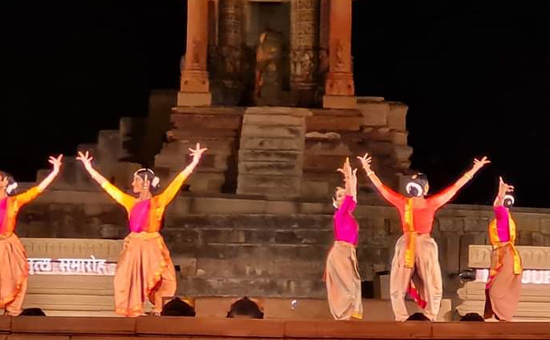 Geeta Chandran with her students.
Geeta Chandran with her students.The first session of 'Kalavarta' saw Bharatnatyam exponent 'Geeta Chandran'. She started with an invocation of lord Ganesh in Carnatic style. Geetaji also shared her experiences of her performance the previous evening along with the aspects of transforming a stage performance to site-specific performance. She says," The challenge is that your presentation must suit not only the grandeur of the monuments and their history, but also create a dialogue with the monument."
She further described how important it is for an artist to merge with the surroundings of the performance giving importance to the sense of contextualising art. She said, "It is easy to learn an art form, master it and be a good performer, but how to contextualise it to present to your audiences is a real challenge. The idea is to make the art accessible and easy to understand."
Geetaji
further threw light on various aspects of Bharatnatyam as a dance form and its
evolution, namely its journey from temples to the courts and houses of the
nobles, and how it was envisaged and reconstructed for the stage performances.
She says, "The form you see today is the reconstructed form of Bharatnatyam which is nearly 100 years old. While change is the only constant, but we still need to define the direction of change, like in a flowing river you can define the banks but not the flow. Art being subjective, one must try to discover the layers of dance and its vocabulary. She further elaborated on the sequence of performance called 'Margam' in Bharatnatyam which is both learnt and taught in a definite format starting from 'Alarippu', 'Jatiswaram', 'Shabdam', 'Varnam', 'Padam', 'Jawali', 'Kirtanam', 'Tillana' and 'Shlokam', which are the musical formats also.
While her students demonstrated the movements, Geetaji further explained the importance of subtleties in dance for e.g. 'Alarippu' has simple body movements of hands, eyes and shoulders which are subtle and very dignified. She said, "One has to learn the very technique of how to coordinate the shoulder movement along with the subtle eye movement in that very second, which can only be learnt from a guru. Alarippu is the first stage of Bharatnatyam which is taught at the age of 7, which is like a benchmark and unless it's crossed one cannot be a dancer.
So it is a journey of understanding the subtle nuances first and then go to the louder movements, which needs to be consciously taught to this generation of students."
She also threw light on the rhythm aspect of the pure dance form of Bharatnatyam which is produced by a 'Mridangam', a 'Talam' (an instrument like Manjira) followed by the 'Feet' which works simultaneously on the same beat and pieces as played on Talam. She also explained various facets of the form along with the changing trends in the format, which are seen today in the name of innovation.
She concluded by saying, "We must always try to understand the purpose of learning music and dance. As whatever art you learn it is ultimately going to translate, into making you a good human being, and that's the purpose of art in society, which we see lacking today. We need to have art appreciation courses and it needs to be a part of our educational curriculum in schools from an early age."
 Geeta Chandranji
Geeta ChandranjiAnother interesting session in 'Kalavarta' saw a presentation by the Architect 'Shikha Patidar' who threw light on the 'Vernacular Architecture of the Rajwar Community' in Central India, known for their nature-friendly dwellings.
 Architect Shikha ji.
Architect Shikha ji.Her presentation showed how the vernacular architecture is built with resources available in the region and based on the local needs of the Rajwar community. Made of mud, water, straw and wood, these houses reflect their local traditions and cultural practices, as they are made without disturbing nature and the ecological systems. The knowledge of making is passed on orally from one generation to another. The designs, motifs, patterns and structures are both traditional and individualistic. One thing to note is that all this is done without the presence of an architect.
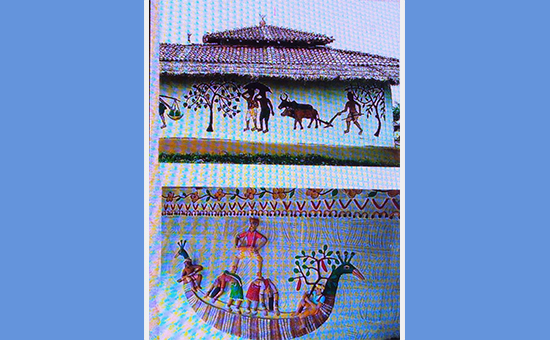 Rajwar folk art.
Rajwar folk art.Rajwar's have maintained their ecological equilibrium and their environment for ages. They live in joint families and celebrate life to the fullest from childbirth to marriage and have rituals and beliefs associated with the trees which they never cut as they worship nature.
Even
their names are inspired by trees, plants and animals like Nagbangsi,
Dhamara, Singtour and Mukhia, while their jaalis, murals and walls depict
trees, animals and birds in colourful motives. They stay near a natural water
resource and grow medicinal plants, fruits and vegetables
The
Rajwar dwellings have different typologies according to the size of the land
and requirement. The houses are constructed on an elevated platform wherein the
large dwellings, have a courtyard which is surrounded by a columned veranda to
have natural ventilation which opens into the kitchen, bedrooms and the
storeroom.
The semi-covered veranda is called 'Parchi' and the closed veranda is called 'Osar' while the living spaces and bedrooms are called 'Bheetar'.They have a distinct place for their deities called the 'Devghar' in the northeast corner of the house. The small dwellings have only a verandah in the front or side with an open space depending on the space.
The talk
gave ideas to architects and builders and reiterated the need to create
self-reliant and self- sufficient habitats, more green spaces. They can be
built with natural indigenously available materials in the regions, to be used
as per the requirement, which will also enable local employment. This will save
cutting bulks of timber and exploiting natural resources, thus saving mother
earth, like these tribals of Rajwar do.
While for
those who wanted to explore beyond the Art & the Dance Festival, the
Khajuraho Utsav also had Heritage Walks, Village Tours, Camping and Adventure
activities in and around Khajuraho. There were Day Excursion Tours to Orchha,
Dhubela, Panna and Khajuraho, making it a perfect week-long holiday trip.
Inspite
of the well intentioned and monumental efforts of the organisers the festival
did not attract significant crowds. This can partly be explained by Covid19.
Here are some suggestions for the organisers -
Connectivity
needs to be improved for e.g. a functional airport or direct festival trains
from Delhi and other towns. Conducted bus tours could be organised from nearby
towns say Gwalior, Agra and Chitrakoot. Students from schools could be invited
for e.g. Scindia
Girls School, Gwalior or Ramakrishna Mission School, Gwalior. More
crowds encourages performers and results in higher sales of art and craft
products.
To read all articles by author
Some pictures by author, others by Raj Bhendre who covered the festival for Kala Academy Khajuraho.
Also read
1. Khajuraho
Dance Festival 2021
2. Khajuraho
Dance Festival 2021, An Ode to Abhinaya
3. Bharata’s Natya Shastra
4. Chanderi
Saris and their rich history
5. How
to Differentiate and Identify Maheshwari and Chanderi Saris
6. Pics
of Khajuraho Temples Western
7. Pics
of Orchha
8. Deeper
meaning behind erotic sculptures of Khajuraho
9. Konarak
Dance Festival
10. Kuchipudi
Dance at Elephanta Festival
11. Folk
dances of Assam